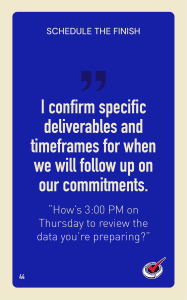When Managing Up, Don’t Bring Data Without a Point of View
When your manager asks you for information, don’t just answer their question. Have a perspective. To get better at managing up, ask yourself three questions that will turn information into influence.
The Problem: Why Your Boss Is Frustrated
Every day we hear from frustrated executives buried in data. Their team sends them reams of information without context, PowerPoint decks that don’t answer the “obvious” question, or vague answers that lead to more questions.
And it’s all unnecessary. If your manager asks you for information and your answers don’t build your influence, or worse, cause frustration, you probably made one of a few mistakes.
Presenting Information: Common Managing Up Mistakes
Avoid these common mistakes when answering questions and presenting information.
Mistake #1: You Misinterpret or Underestimate the Ask
You’re swamped and moving fast. There’s so much to do and then your boss asks for an update. And you want to be responsive, so you quickly throw together a chart that shows the last twelve months. But you don’t explain why February’s numbers were so different. Now your manager wonders why you don’t care about the obvious issue.
You’re so close to the project that your focus is on twigs and leaves, not the tree…and much less the forest. Your manager asks you for information. So you bury them in minutia that’s meaningful to you – but they wanted your perspective on the project’s success. And now they have to ask again.
Your manager asks for your analysis. So you put together a tight description of what’s happening and why. But you don’t make any recommendations. And your frustrated manager wonders, “What am I supposed to do with this? Shouldn’t you be able to solve these problems?”
Mistake #2: You Think Your Boss Thinks Like You
Everyone has a natural style of how they get information and make decisions. But these styles differ from one person to the next.
Maybe you prefer to read. So you prepare excellent written emails and reports – that your manager ignores. Because she prefers to listen and talk through the information. Or, you like to see all the data when deciding, so you give them everything. But they just want a summary, or your suggestion.
Mistake #3: You Try to Stay Out of Trouble
Your manager asks for an update and you bury the bad news in a spreadsheet or a hundred-slide presentation. Rather than interpret the data and risk a negative reaction from your manager, you dump it all on them and leave them to figure it out.
Or you don’t offer a point of view or recommendation because you worry about how your manager will react.
After all, they can’t get mad at you if you said nothing wrong, right?
Well, wrong…of course they can still get upset. And now, to make it worse, you didn’t actually do your job because you didn’t lead.
Mistake #4: You Try to Look Too Good
There’s a time to show your work. But going overboard makes you look insecure, not competent.
When you showboat and point out how outstanding you are, you cast doubt as to your true capabilities. Worse, in the effort to show off, you miss the chance to genuinely help and build the influence you want. You’ll have much more influence managing up when you add true value.
Three Managing Up Questions to Turn Information into Influence
Avoid these four mistakes and add value by asking yourself three key questions. If you aren’t confident in your answers to any of the questions, use these communication tools and Powerful Phrases to maximize your influence.
1. What does your manager need?
This is the most important question to make sure that you add value. What does your manager actually need?
Ask yourself this question a couple times, from different angles.
Because your manager might not ask for what they need.
They’ll ask for what they think they need. Or they ask for the first part, but not the second and third pieces. Maybe they don’t understand the issue as well as you do, so they ask the totally wrong question. Or they don’t specifically ask for your recommendation, but they expect you to have one.
Here are ways to think about what your manager needs:
How will they use the information? Will they make a decision? Pass it to someone else? Implement your suggestion?
Quick or detailed? What level of confidence do they need? Do they need a precise, accurate answer, or is a quick range enough for now?
Do they need nicely formatted to share with others or just an email with a simple answer?
What are the next three questions your manager would naturally ask? Answer these.
Always have a perspective. Whether your manager asked for it, you need to be read to offer a point of view. You are closer to the work. What would you recommend?
If you’re not sure what your manager needs, there are a couple of questions you can ask to help clarify:
Check for Understanding by saying, “Here’s what I’m hearing you need and how you will use the answers I give you: ________. Do I have that right?”
When you don’t have enough information to check for understanding, you can draw out more information by asking: “I want to make sure I get you what you need. What will a successful update do for you?”
2. How do they need it?
When you work with a manager frequently, you can ask this question early in your relationship. If you don’t know the person making the request, include this question in your first conversation:
“How do you like to receive information?”
Some possibilities to explore include:
Written, diagramed, or spoken
Bullet point summaries or analysis
Numbers, narrative, or both
When you can’t know how they need it, try this: start with a one-page brief, bulleted summary of key information and your recommendations. In the following pages, give them the data and analysis. Then make yourself available to discuss the report.

3. When do they need it?
You don’t want to waste time if they need it quickly. Nor do you want to drop everything and abandon your work to provide a report that could wait until next week.
The tool to help you manage these priorities is Scheduling the Finish.
You never want to leave a conversation that requires action without scheduling the finish by addressing three factors:
Ideally, when will the task be complete?
Is this workable, or do you need to resolve competing priorities?
Is the scheduled finish on your calendar (and the calendar of anyone else involved)?
For example, your manager asks for an update on the sales figures for your newest product. You know she prefers written bullet points and the ability to ask clarifying questions.
First, you ask how she’ll use the data and whether she wants the actual data or a trend analysis. Then you schedule the finish by asking, “Ideally, when do you need this?”
She asks for the information by tomorrow afternoon.
You have time at 4:00 pm available to meet. But you also have to attend a marketing update in the morning that won’t leave you time for her update.
So, you tell her, “If I can skip that marketing meeting, I can send you the information at 3:00 and then we can do a quick video call at 4:00 so I can answer your questions? How does that sound?”

Your Turn
You can master the art of managing up, increase your influence, and get your manager the right information at the right time by answering three critical questions: What do they need? How do they need it? When do they need it?
We’d love to hear from you: what’s one of your best ways to get your manager the information they need to lead well and make good decisions?
You Might Also Like:


